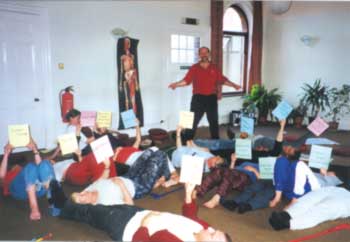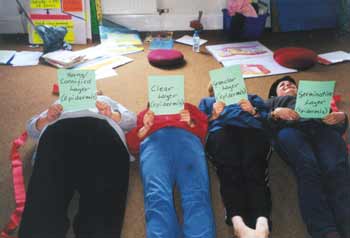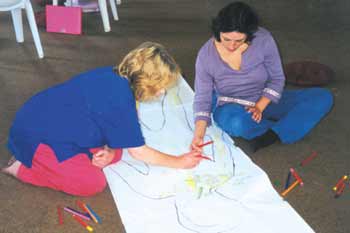Positive Health Online
Your Country

The Role of Anatomy and Physiology in Bodywork
by Darien Pritchard(more info)
listed in anatomy and physiology, originally published in issue 54 - July 2000
At present Anatomy and Physiology sit uneasily in much bodywork training and practice. In this article I want to look at their place and relevance. What is the situation at the moment? Unfortunately in some areas it's poor. It's not unusual, for example, to have a massage from someone who can't tell you anything about the tensions they've just worked on in your body – what muscles they're in, what actions those muscles do, why there might be tension there, and what 'homework' exercises you (the client) could do to address the buildup of this tension.

The style of teaching Anatomy and Physiology can affect students' attitudes to its potential worth when they become practitioners
But before the reader assumes that I'm therefore advocating a view that anatomy is the only thing that matters, let me say that my ideal for bodywork is an interweaving of science and art – the appropriate knowledge applied in a way that acknowledges and works with the client's needs and comforts. One of the major challenges to a beginning bodyworker is getting the balance right, between knowledge, sensing what's under your hands and the intuitions that come to you as you work.
So what does a bodyworker need to know?

Training for practitioners should familiarize them with ther terminology of human biology
Appropriate Knowledge
Obviously, bodywork practitioners need a basic understanding of anatomy and kinesiology and some physiology (see sidebar on left), the emphasis and detail being determined by their speciality (e.g. a massage practitioner doesn't need to know nearly as much as a chiropractor about the nervous system).
In recent decades, the upsurge of research on stress management has highlighted useful information that should be part of a bodyworker's repertoire, as two aspects of bodywork can benefit from an understanding of the physiological dynamics of stress and relaxation. Helping the client to relax – either teaching relaxation or at least the creation of a relaxed working atmosphere – is an important component of most treatments. Professionals should be able to explain to clients the body's responses to short-term and long-term stress.
Those modalities that are designed to affect the functioning of the body systems (e.g. shiatsu, reflexology) clearly need to incorporate considerable physiology and pathology training.
Where physiology and pathology fit for other bodyworkers is not so obvious. It has often been assumed that these bodyworkers don't need to ask clients about their health, apart from any obvious injuries, aches or pains. Whether or not this was satisfactory in the past, it is certainly not so now – the wide publicity and growing interest in bodywork means that the practitioner is seeing a clientele with a wider range of conditions than a decade ago; in fact many people who are unhappy with the response of the medical system to their problems are willing to try out all sorts of health practitioners to see if they have anything more to offer.
This highlights the role of anatomy, physiology and pathology knowledge in bodywork. It is crucial in determining guidelines on contra-indications, cautions to be exercised and parameters within which to work with a client.
Its purpose also is to be available and at the service of the practitioner's hands (to make them intelligent) – allied with the practitioner's intuitions and sensing (of the micro-responses in the tissues, and the larger overall responses of the client).
So it's important to have a basic grasp of the body's structure, functioning and common problems, but training needs to go beyond being just this catalogue of facts to be useful. Although diagnosing medical conditions is outside the scope of their training, practitioners should be able to make sense of the information that the client gives to them.
If the client has already had a skilled medical diagnosis, the practitioner needs to be able to make use of this. Training for practitioners should, therefore, familiarize them with the terminology of human biology and how the words are built up. It should cover the process of researching in medical books for information and how to make sense of this information – particularly what the likely effects on the relevant body tissues and areas will be – and how this understanding will shape the parameters within which to work.
This will often lead to further questions about how the condition affects the client and therefore the treatment session (e.g. if they have difficulty in lying down comfortably; or areas of the body not to be touched), or to elicit 'safety' information (e.g. if the client is diabetic – is their blood sugar level presently steady and likely to remain so? What are the symptoms that will indicate if they are becoming hypoglycaemic and what do they need the bodyworker to do in that case?).
Ideally, practitioners should be able to work out which professionals to refer clients to, if needed, and how to question the client, if necessary, to make some sense of any undiagnosed conditions. Bodyworkers should also be able to talk to other professionals in medical language – to share information and to explain relevant aspects of their work.
Additionally, practitioners should learn to use textbooks to research things which they've discovered with their hands during the treatment (e.g. investigating the structure of a joint, or identifying the muscles in which tension was found).

Teaching Anatomy and Physiology can be brought to life by active teaching aids
The Role of Teaching Methods
I think that there's another factor that can be just as significant as the inclusion or not of areas of anatomy and physiology (A&P) study in shaping the beginning practitioner's attitude to A&P, and that is how it is taught.
Because of previous experience of learning biology as an abstract academic subject, many people have questions about why they are learning it. And the style of teaching can feed into this, affecting the student's attitude to its inclusion in a course, how much they learn from it, and its potential for them to use as a practitioner.
It can be presented in a way that opens up useful applications. Or it may not – which was the case In my own initial massage training over twenty years ago; the teaching about muscles was done in such a 'bookish' way that we students learned it by rote to pass the exam, with very little idea that it might relate to the massages we did. (This article represents some of my thoughts as I've developed from there as both teacher and practitioner.)
Sometimes bodywork courses can deliver two different messages via the teaching – exciting 'hands-on' teaching of the most relevant areas, usually muscles, bones and joints, (which tells the students that this is the important stuff), and boring lectures on the rest of the A&P material ("Ignore this!").
All too often, Human Biology is taught only via lectures and written homework, presenting boring, 'sterile' lists without apparent purpose – beyond being crammed for an exam and then forgotten. If it is not brought to life via the teaching, and related to the specific modality being studied, it reinforces the negative perspective of biology as irrelevant to the practical bodywork skills. This can be especially problematic in courses which have 'generic' anatomy, physiology and pathology designed to serve a number of different modalities.
When I first ran a professional massage course, I had a colleague teaching the anatomy and physiology. He initially operated in 'lecture' mode only, overwhelming the students with information – which meant they soon lost interest. I had to ask him to reduce the amount he covered in each session, to make his presentations more varied, and we had to do considerable planning together on how to make connections with the practical concerns of massage.
Information becomes useful for a bodywork student when it can be grounded in experience. Much anatomy and kinesiology can best be studied via palpation of muscles, bones and joints in action (ideally on a number of people to get a broad understanding), backed up by looking at written information.
The teaching of the less directly palpable aspects, particularly physiological processes, can be made relevant by discussion, images, examples, and imaginative teaching. In recent years, even mainstream education has begun to move away from using lectures as the main form of teaching, now emphasizing that the delivery of information needs to be consolidated by the students working with it in a variety of ways – via discussion, debate, application, simulation, team projects, problem solving, etc.
To give variety to my own teaching, I use a range of teaching methods (e.g. brainstorming, role plays, experiential learning, guided fantasy journeys in the body, researching in books) and active teaching aids that I've developed (e.g. flash cards, information sorting packs, colouring in charts, review questionnaires etc.) to complement the 'traditional' charts and models. I also get students to present review material that they have created (e.g. wordsearches, questionnaires and crosswords, rap songs etc), and to do revision with fellow students (as well as working alone with books, CDROM etc).
Applying the Information
There are two other potential sources of conflict between A&P information and practical bodywork. Many beginning students fear that this information will overwhelm their fragile, newly-emerging palpation skills – the teacher should coach them in developing a healthy relationship between the two types of input by giving them information which can be investigated and reinforced by 'hands-on' (e.g. learning bones by touching, not just by writing names on diagrams), and getting them to palpate things that then encourage book research (e.g. initially studying the movements of a joint by feeling it on oneself and/or a partner).
There can also be similar ambivalence on the part of some trainers, particularly as increased public recognition and the struggle for national registration increases the pressure to 'medicalize' bodywork – i.e. to justify it in medical terms only, downgrading or ignoring the importance of friendly, interested, nurturing touch. The fear is that students will operate only within channels defined wholly by a very narrow application of medical information (e.g. viewing information about the range of a joint as a directive to attempt to force this range on every client), not adapting to different clients and also losing the larger perspectives that underpin the particular approach.
Moshe Feldenkrais, for example, was concerned that students of his Method might reduce the techniques merely to a way of working on isolated muscles and joints – instead of focusing on integrated movement throughout the body and also on the client's involvement in this process of re-education. And in Holistic Massage, the concern is that students will discount intuition, and ignore the importance of the interpersonal connection between practitioner and client, coming instead to view themselves as experts armed with immutable knowledge which will allow them to 'fix' the passive client.
These concerns can best be tackled by the teacher demonstrating where knowledge of anatomy and physiology fit together and how to use this knowledge, both the information gathered from the client and the practical work, and then setting up practice sessions for the students that require them to apply A&P in a similar way.
So I hope that, rather than leaving the beginning practitioner to spend time ignorant and stumbling in the dark as I was, this article points the way towards the development of a more well-rounded practitioner (which is the ideal), able to marry sensing and knowledge, analysis and intuition, and take into account medical conditions that will influence the intentions and shape of a treatment sessions (and to understand something of the dynamics of the professional relationship – but that's beyond the scope of this article), and thus to deliver the best service for their clients.
Definitions:
For those unfamiliar with the specific meanings, Anatomy refers to the structure of body parts – from the large to the microscopic – Physiology to the body's functioning – i.e. the chemical processes that go on at all these levels – Pathology to problems or disorders, and 'Kinesiology' to the actions of muscles in movement. Human Biology is a term hat covers all these component areas.
In this article, bodywork refers to the range of approaches that work on the physical body in non-chemical ways (e.g. massage, Rolfing, muscle energy technique, shiatsu, reflexology) including those methods whose focus is primarily on using physical work to affect brain functioning (e.g. the Alexander Technique the Feldenkrais Method).
References
1 The British Medical Association Complete Family Health Encyclopaedia Ed Dr Tony Smith. Dorling Kindersley (ISBN 0-86318-483-3). London 1990.
2 Olsen A. Body Stories – A Guide to Experiential Anatomy. Station Hill Press (ISBN 0-88268-106-0). New York. 1991.
3 Parker S. How the Body Works. Dorling Kindersley (ISBN 0-7513-0081-0). London. 1994.
The first is an excellent reference book for practitioners. The other two are useful for teachers of Anatomy, Physiology and Pathology. Andrea Olsen is a dance teacher, who therefore focuses mainly on the skeleton, muscles and breathing. Steve Parker's book covers learning games for school teaching, but much is adaptable for teaching bodyworkers.
Comments:
-
No Article Comments available